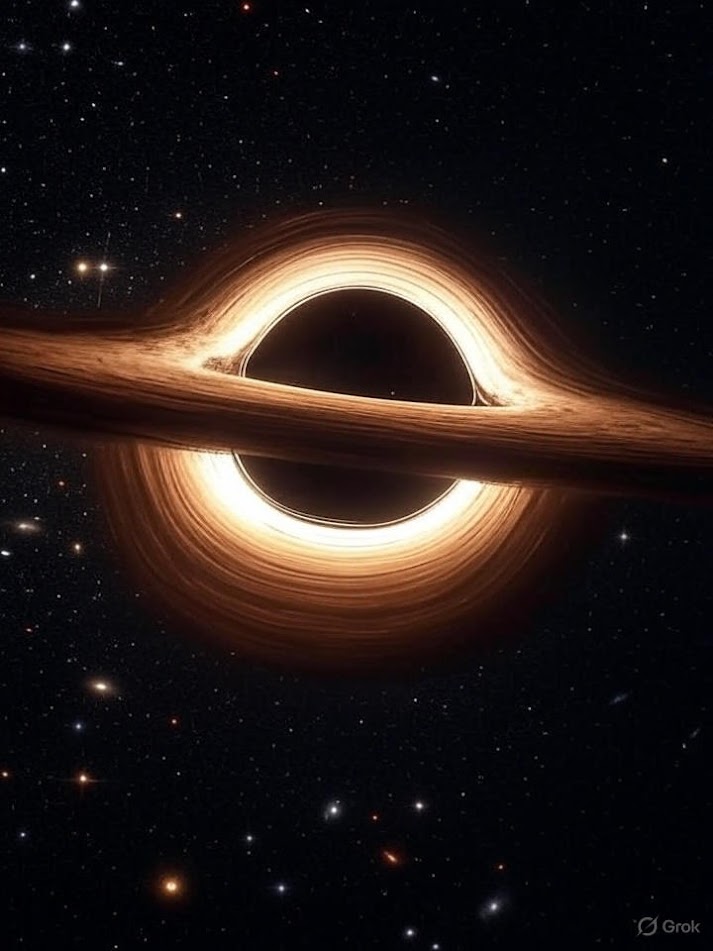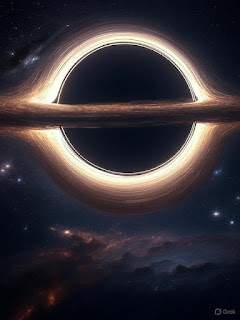Black Holes: The Cosmic Enigmas
Black Holes: The Cosmic Enigmas
Introduction
Black holes are among the most mysterious and fascinating objects in the universe. They are regions in space where gravity is so intense that nothing, not even light, can escape their grasp. This article explores the nature of black holes, their formation, properties, types, and the historic first image of a black hole, examining the profound impact they have on our understanding of physics and the cosmos.
 |
| Black Holes: The Cosmic Enigmas |
Mangalyaan: India's MOM Mission to Mars
What is a Black Hole?
A black hole is a region of spacetime where gravity is so strong that it warps the fabric of spacetime, preventing anything from escaping, including light. This makes black holes invisible to direct observation, and they are detected only through their gravitational effects on surrounding matter or through radiation emitted by material as it falls toward them.
The boundary surrounding a black hole is called the event horizon. Once an object crosses this boundary, it is lost to the outside universe. The event horizon is not a physical surface but a point of no return. At the center of a black hole lies the singularity, a point where density is theoretically infinite, and the laws of physics as we know them break down.
Formation of Black Holes
Black holes form through several processes, primarily the gravitational collapse of massive stars:
Stellar Collapse: The most common way black holes form is when a massive star (at least eight times the mass of the Sun) exhausts its nuclear fuel. Without the outward pressure from nuclear fusion to counterbalance gravity, the star collapses under its own weight. If the core's mass is sufficient, it forms a black hole.
Supernova Explosions: In some cases, a massive star undergoes a supernova explosion, ejecting its outer layers while the core collapses into a black hole or a neutron star, depending on the core's mass.
Mergers: Black holes can also form through the merger of two neutron stars or a neutron star with another black hole, resulting in a more massive black hole.
Primordial Black Holes: Hypothetical black holes may have formed in the early universe due to density fluctuations shortly after the Big Bang. These remain speculative and have not been confirmed.
Types of Black Holes
Black holes are classified based on their mass, spin, and charge:
Stellar-Mass Black Holes:
- Mass: 3 to 100 times the Sun's mass.
- Formation: Result of the collapse of massive stars.
- Example: Cygnus X-1, one of the first confirmed black holes, was detected through X-ray emissions from its accretion disk.
Supermassive Black Holes:
- Mass: Millions to billions of times the Sun's mass.
- Location: Found at the centers of most galaxies, including the Milky Way (Sagittarius A*).
- Formation: Likely formed through the accretion of mass or mergers of smaller black holes over cosmic time.
Intermediate-Mass Black Holes:
- Mass: 100 to 100,000 times the Sun's mass.
- Formation: May form through the merger of stellar-mass black holes or in dense star clusters.
- Evidence: Still being studied, with candidates detected in some globular clusters.
Primordial Black Holes:
- Mass: Could range from very small (less than a stellar mass) to larger sizes.
- Formation: Hypothetically formed in the early universe.
- Status: No confirmed detections, but they are considered potential candidates for dark matter.
Kerr and Charged Black Holes:
- Kerr Black Holes: Rotating black holes, described by the Kerr metric, which differ from non-rotating (Schwarzschild) black holes.
- Charged Black Holes: Have an electric charge, described by the Reissner-Nordström metric, though charged black holes are rare in nature.
Key Properties of Black Holes
Black holes are characterized by three primary properties:
- Mass: Determines the strength of the gravitational pull and the size of the event horizon.
- Spin: Many black holes rotate, which affects the structure of the event horizon and the behavior of nearby matter.
- Charge: Though most black holes are electrically neutral, theoretical models include charged black holes.
The no-hair theorem suggests that black holes are fully described by these three properties, meaning they lack other distinguishing features like shape or surface details.
Observing Black Holes
Since black holes emit no light, they are detected indirectly through:
- Accretion Disks: Matter falling into a black hole forms a rotating disk, heating up and emitting X-rays or other radiation.
- Gravitational Effects: Black holes warp spacetime, causing nearby stars or gas to orbit in distinctive patterns.
- Gravitational Waves: Detected by observatories like LIGO, these ripples in spacetime are produced when black holes merge.
- Event Horizon Telescope: In 2019, this project captured the first image of a black hole’s shadow, a groundbreaking achievement discussed below.
The First Black Hole Image
On April 10, 2019, the Event Horizon Telescope (EHT) collaboration unveiled the first-ever image of a black hole, located at the center of the Messier 87 (M87) galaxy, approximately 55 million light-years from Earth. This supermassive black hole, with a mass of 6.5 billion times that of the Sun, was captured using a global network of radio telescopes working together as a virtual Earth-sized telescope.
 |
Astronomers Reveal First Image of the Black Hole at the Heart of Our Galaxy |
The Vishnu Vision: India’s Hypersonic Missile Milestone
Details of the Image
- Appearance: The image shows a bright ring of light surrounding a dark central region, known as the black hole’s shadow. The bright ring is the accretion disk, composed of matter heated to extreme temperatures as it spirals toward the event horizon. The dark central region is the shadow cast by the event horizon, where light is bent or absorbed by the black hole’s gravity.
- Significance: This image confirmed predictions of Einstein’s general relativity, particularly the shape and size of the event horizon. The asymmetry in the ring’s brightness is attributed to the black hole’s rotation and the Doppler effect, where material moving toward Earth appears brighter.
- Technical Achievement: The EHT used Very Long Baseline Interferometry (VLBI), combining data from eight observatories across the globe, including telescopes in Chile, Hawaii, and Antarctica. The data collected was equivalent to petabytes, requiring sophisticated algorithms to reconstruct the image.
- Impact: The M87 black hole image provided visual evidence of black holes, previously inferred only indirectly. It also opened new avenues for studying black hole physics, including tests of general relativity in extreme gravitational environments.
In 2022, the EHT collaboration released an image of the Milky Way’s supermassive black hole, Sagittarius A*, further advancing our understanding of these cosmic phenomena. However, the M87 image remains iconic as the first of its kind.
Black Holes and Physics
Black holes challenge our understanding of physics, particularly at the intersection of general relativity and quantum mechanics:
General Relativity: Albert Einstein’s theory describes black holes as solutions to his field equations, predicting phenomena like the event horizon and singularity. The EHT image of M87 validated these predictions.
Hawking Radiation: Proposed by Stephen Hawking, black holes can emit radiation due to quantum effects near the event horizon, causing them to slowly lose mass and potentially evaporate over immense timescales.
Information Paradox: Hawking radiation raises questions about whether information that falls into a black hole is lost forever, challenging the quantum idea that information is conserved.
Singularity and Quantum Gravity: The singularity, where density becomes infinite, suggests a need for a theory of quantum gravity to reconcile general relativity with quantum mechanics.
Black Holes in Popular Culture
Black holes have captured the public’s imagination, appearing in films like Interstellar (2014), which depicted a scientifically inspired black hole called Gargantua, and in literature and video games. The M87 black hole image further fueled public fascination, providing a real-world glimpse of these enigmatic objects.
 |
| Black Holes: The Cosmic Enigmas |
Honda Makes Historic Leap with First Reusable Rocket Launch and Landing in Japan
Recent Discoveries and Future Research
- Event Horizon Telescope: The 2019 M87 image and the 2022 Sagittarius A* image marked milestones in astrophysics, confirming theoretical predictions.
- LIGO and Virgo: Since 2015, these observatories have detected dozens of black hole mergers, providing insights into their populations and formation.
- Future Missions: Projects like the James Webb Space Telescope and the upcoming LISA (Laser Interferometer Space Antenna) aim to study black holes in greater detail, particularly their role in galaxy formation and early universe dynamics. Future EHT observations may produce sharper images or even movies of black hole dynamics.
Conclusion
Black holes are more than just cosmic curiosities; they are key to unlocking the mysteries of the universe. The first image of the M87 black hole in 2019 was a landmark achievement, providing visual proof of these invisible giants and confirming decades of theoretical work. From their formation in the fiery deaths of stars to their role at the hearts of galaxies, black holes challenge our understanding of physics and inspire awe. As technology advances, we are poised to uncover even more about these enigmatic objects, bringing us closer to understanding the fundamental nature of spacetime and the cosmos.
Read more:
NISAR: Earth’s Watchdog from Space















Post a Comment